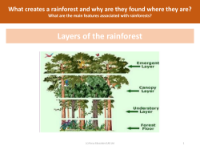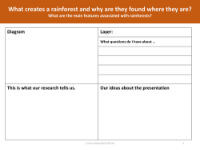What are the main features associated with rainforests? - Teacher notes

Geography Resource Description
Rainforests, often referred to as the lungs of our planet, are rich ecosystems teeming with life and distinctive features. One of the most prominent characteristics of rainforests is their layered structure, which includes the emergent layer, canopy layer, understory layer, and forest floor. Each layer is home to a unique set of flora and fauna adapted to the conditions found at that particular height and light level. The emergent layer is the highest, with towering trees that rise above the rest, while the canopy layer forms a dense roof of foliage which is the primary layer of the rainforest and supports a vast majority of the life forms. Below this, the understory layer is characterised by shorter plants and receives less light, and finally, the forest floor, which is the lowest layer, is often dark and covered with decomposing leaves and other organic material.
The geographical distribution of rainforests is another key feature, as they are typically found in the equatorial regions of the world. This location is crucial because it provides the warm and humid climate that rainforests require to thrive. The constant warmth and high levels of rainfall create an environment that supports the growth of an incredible diversity of plant and animal species. In addition to their biological importance, rainforests play a vital role in the global climate by producing oxygen and storing carbon dioxide. Understanding the structure and function of each layer is essential for appreciating the complexity and significance of these ecosystems. Group research activities, where each member investigates one layer, can be an effective method for students to learn about and present the intricate details of rainforest features to their peers.





